Diabetes in Older Adults: Types, Causes, Symptoms, Diagnosis, and Treatment
VerifiedAdded on 2023/06/07
|12
|3370
|149
AI Summary
This article provides a comprehensive overview of diabetes in older adults, including types, causes, symptoms, diagnosis, and treatment options. It emphasizes the impact of the disease on the elderly population and highlights the importance of prevention and management strategies.
Contribute Materials
Your contribution can guide someone’s learning journey. Share your
documents today.
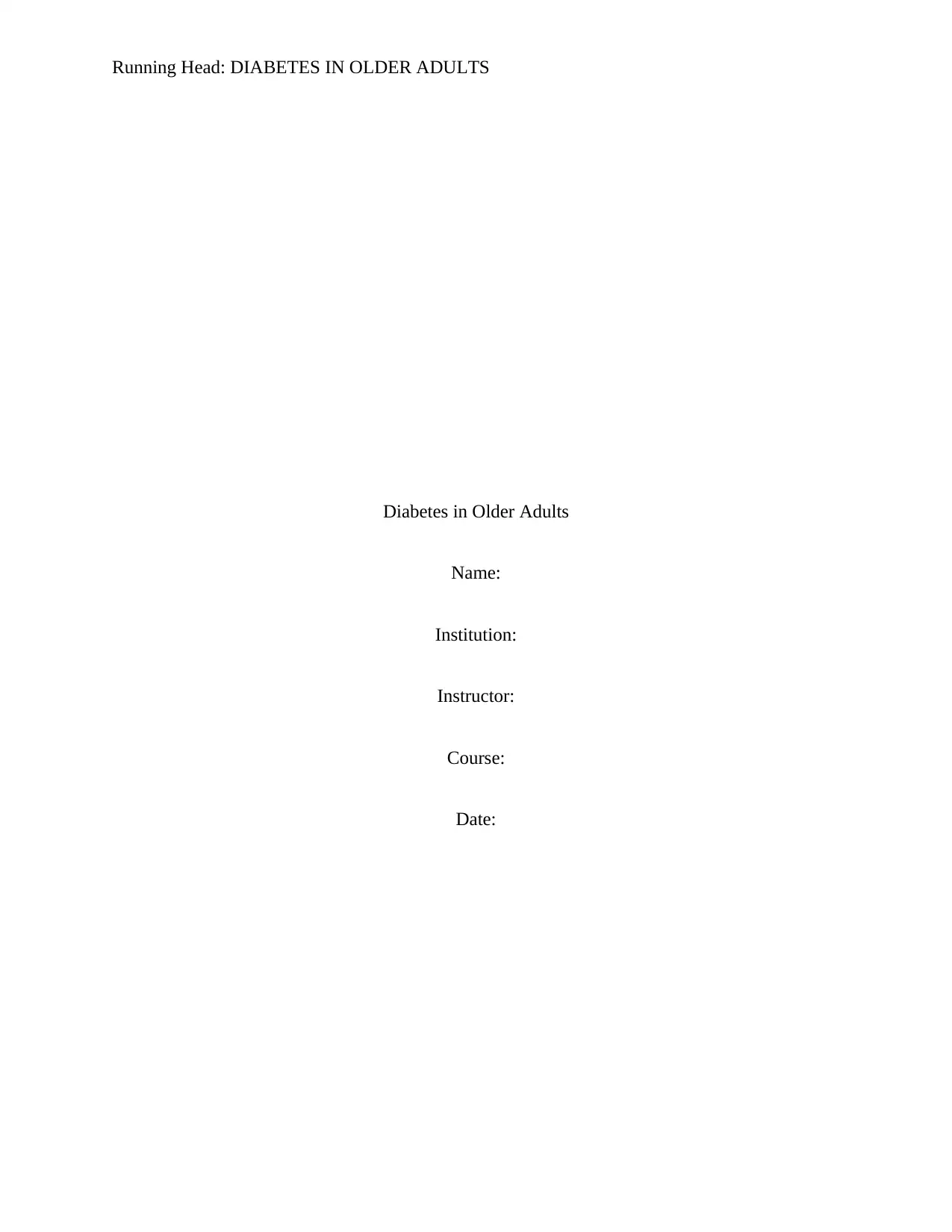
Running Head: DIABETES IN OLDER ADULTS
Diabetes in Older Adults
Name:
Institution:
Instructor:
Course:
Date:
Diabetes in Older Adults
Name:
Institution:
Instructor:
Course:
Date:
Secure Best Marks with AI Grader
Need help grading? Try our AI Grader for instant feedback on your assignments.
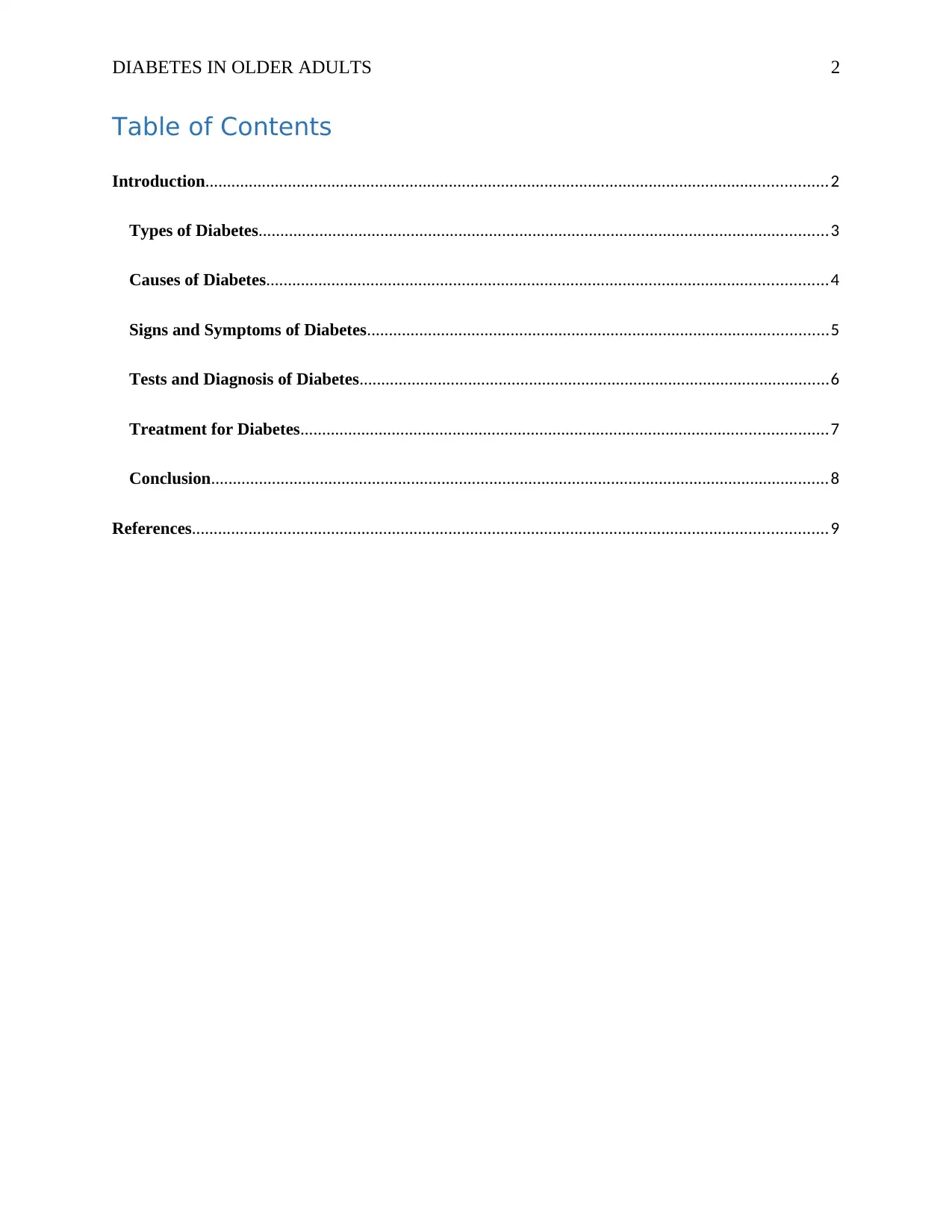
DIABETES IN OLDER ADULTS 2
Table of Contents
Introduction...............................................................................................................................................2
Types of Diabetes...................................................................................................................................3
Causes of Diabetes.................................................................................................................................4
Signs and Symptoms of Diabetes..........................................................................................................5
Tests and Diagnosis of Diabetes............................................................................................................6
Treatment for Diabetes.........................................................................................................................7
Conclusion..............................................................................................................................................8
References..................................................................................................................................................9
Table of Contents
Introduction...............................................................................................................................................2
Types of Diabetes...................................................................................................................................3
Causes of Diabetes.................................................................................................................................4
Signs and Symptoms of Diabetes..........................................................................................................5
Tests and Diagnosis of Diabetes............................................................................................................6
Treatment for Diabetes.........................................................................................................................7
Conclusion..............................................................................................................................................8
References..................................................................................................................................................9

DIABETES IN OLDER ADULTS 3
Introduction
Diabetes is a chronic infection which makes a patient's body not capable of producing
insulin or not make proper use of insulin which it produces. Insulin is a hormone which is
produced in the body to control the amount of glucose in the blood. However, the human body
needs the right amounts of sugar which it uses as a source of energy (Díaz-López et al., 2016).
The prevalence of this infection is increasing due to the aging aboriginal population and the rapid
increase in obesity in these communities. Change of lifestyle is also another contributor to the
increasing of diabetes especially for individuals who are over 75 years. Diabetes is a primary
cause of death in many developing countries because they are still not able to implement
treatment and medication techniques which can reduce the spread of this health risk (Carlsson,
Risérus & Ärnlöv, 2014). In old people, diabetes is a disabling disease which is associated with
vascular complications. Due to the heterogeneous nature of old people with diabetes and
variations in their functional status, comorbidities and life expectancy (Wong, Lin & Russell,
2017). This paper focuses on the types of diabetes, causes of diabetes, diagnosis of the infection,
signs, and symptoms of the infection, prevention, treatment of diabetes and effects of the disease
to the society.
Types of Diabetes
There are various types of diabetes which can infect old people in our society. Type 1
diabetes is the first form of diabetes which occurs when the body of a patient attacks the beta
cells of the pancreas and kills them by mistake. According to Santos (2018), destruction of better
cells leads to the reduced amount of insulin which is supplied to the body. This leads to sugar
been built up in the blood instead of it been used as a source of energy in the body. This type of
diabetes is not very common in old people as it affects children or young people in their
adolescent. Patients with type 1 diabetes can only be treated through the use of insulin which is
Introduction
Diabetes is a chronic infection which makes a patient's body not capable of producing
insulin or not make proper use of insulin which it produces. Insulin is a hormone which is
produced in the body to control the amount of glucose in the blood. However, the human body
needs the right amounts of sugar which it uses as a source of energy (Díaz-López et al., 2016).
The prevalence of this infection is increasing due to the aging aboriginal population and the rapid
increase in obesity in these communities. Change of lifestyle is also another contributor to the
increasing of diabetes especially for individuals who are over 75 years. Diabetes is a primary
cause of death in many developing countries because they are still not able to implement
treatment and medication techniques which can reduce the spread of this health risk (Carlsson,
Risérus & Ärnlöv, 2014). In old people, diabetes is a disabling disease which is associated with
vascular complications. Due to the heterogeneous nature of old people with diabetes and
variations in their functional status, comorbidities and life expectancy (Wong, Lin & Russell,
2017). This paper focuses on the types of diabetes, causes of diabetes, diagnosis of the infection,
signs, and symptoms of the infection, prevention, treatment of diabetes and effects of the disease
to the society.
Types of Diabetes
There are various types of diabetes which can infect old people in our society. Type 1
diabetes is the first form of diabetes which occurs when the body of a patient attacks the beta
cells of the pancreas and kills them by mistake. According to Santos (2018), destruction of better
cells leads to the reduced amount of insulin which is supplied to the body. This leads to sugar
been built up in the blood instead of it been used as a source of energy in the body. This type of
diabetes is not very common in old people as it affects children or young people in their
adolescent. Patients with type 1 diabetes can only be treated through the use of insulin which is

DIABETES IN OLDER ADULTS 4
provided to the patient through injections into their blood. The second kind is type 2 diabetes
which occurs when the body cannot make proper use of insulin (Huang, Basanta, Kuo & Huang,
2018). This leads to sugar accumulating in the blood instead of being used as energy. The largest
percentage of patients suffering from type 2 diabetes. Old people among the aboriginals have this
kind of diabetes.
Lower cases of young people and children who have type 2 diabetes have been reported
as it is prone to mature and old people. Individuals can manager this infection through physical
activities which involve keeping their body fit and planning their meals by taking balanced diets
which have health benefits for their bodies (Tresserra-Rimbau et al., 2016). Healthcare
professionals also administer treatment to the patients who may also include insulin to control
the level of sugar in the blood more effectively. The last type of diabetes is gestational diabetes
which healthcare professionals term it as a temporary condition which occurs in pregnant
women. However, only a small percentage of women have this type of diabetes depending on the
risk factors which they are exposed to (Nankervis, Price & Conn, 2018). Gestational diabetes can
be very harmful both to the mother and the unborn child.
Causes of Diabetes
Causes of diabetes depend on genetic makeup, family history of an individual and
environmental factors which surrounds a person. American Diabetes Association (2017) states
that healthcare professionals are not still in a position to identify the causes of diabetes because
the cause of this infection varies depending on the type and person. Which means each type of
diabetes has specific purposes. The exact cause of diabetes type 1 is still unknown, the only thing
which is clear to healthcare professionals is that the immune system of any individual fight
harmful bacteria and viruses which attacks the body (Nilsson et al., 2017). Healthcare
provided to the patient through injections into their blood. The second kind is type 2 diabetes
which occurs when the body cannot make proper use of insulin (Huang, Basanta, Kuo & Huang,
2018). This leads to sugar accumulating in the blood instead of being used as energy. The largest
percentage of patients suffering from type 2 diabetes. Old people among the aboriginals have this
kind of diabetes.
Lower cases of young people and children who have type 2 diabetes have been reported
as it is prone to mature and old people. Individuals can manager this infection through physical
activities which involve keeping their body fit and planning their meals by taking balanced diets
which have health benefits for their bodies (Tresserra-Rimbau et al., 2016). Healthcare
professionals also administer treatment to the patients who may also include insulin to control
the level of sugar in the blood more effectively. The last type of diabetes is gestational diabetes
which healthcare professionals term it as a temporary condition which occurs in pregnant
women. However, only a small percentage of women have this type of diabetes depending on the
risk factors which they are exposed to (Nankervis, Price & Conn, 2018). Gestational diabetes can
be very harmful both to the mother and the unborn child.
Causes of Diabetes
Causes of diabetes depend on genetic makeup, family history of an individual and
environmental factors which surrounds a person. American Diabetes Association (2017) states
that healthcare professionals are not still in a position to identify the causes of diabetes because
the cause of this infection varies depending on the type and person. Which means each type of
diabetes has specific purposes. The exact cause of diabetes type 1 is still unknown, the only thing
which is clear to healthcare professionals is that the immune system of any individual fight
harmful bacteria and viruses which attacks the body (Nilsson et al., 2017). Healthcare
Secure Best Marks with AI Grader
Need help grading? Try our AI Grader for instant feedback on your assignments.
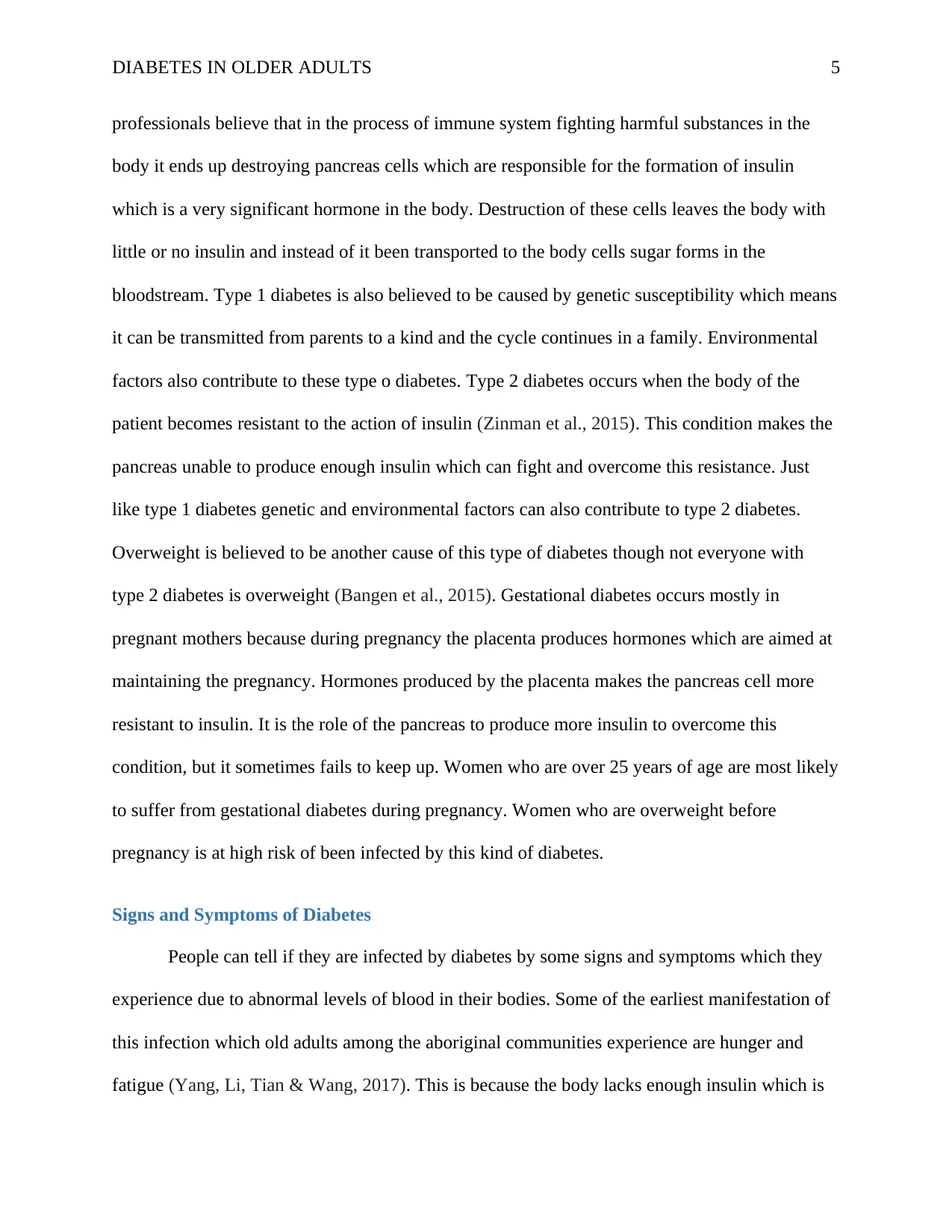
DIABETES IN OLDER ADULTS 5
professionals believe that in the process of immune system fighting harmful substances in the
body it ends up destroying pancreas cells which are responsible for the formation of insulin
which is a very significant hormone in the body. Destruction of these cells leaves the body with
little or no insulin and instead of it been transported to the body cells sugar forms in the
bloodstream. Type 1 diabetes is also believed to be caused by genetic susceptibility which means
it can be transmitted from parents to a kind and the cycle continues in a family. Environmental
factors also contribute to these type o diabetes. Type 2 diabetes occurs when the body of the
patient becomes resistant to the action of insulin (Zinman et al., 2015). This condition makes the
pancreas unable to produce enough insulin which can fight and overcome this resistance. Just
like type 1 diabetes genetic and environmental factors can also contribute to type 2 diabetes.
Overweight is believed to be another cause of this type of diabetes though not everyone with
type 2 diabetes is overweight (Bangen et al., 2015). Gestational diabetes occurs mostly in
pregnant mothers because during pregnancy the placenta produces hormones which are aimed at
maintaining the pregnancy. Hormones produced by the placenta makes the pancreas cell more
resistant to insulin. It is the role of the pancreas to produce more insulin to overcome this
condition, but it sometimes fails to keep up. Women who are over 25 years of age are most likely
to suffer from gestational diabetes during pregnancy. Women who are overweight before
pregnancy is at high risk of been infected by this kind of diabetes.
Signs and Symptoms of Diabetes
People can tell if they are infected by diabetes by some signs and symptoms which they
experience due to abnormal levels of blood in their bodies. Some of the earliest manifestation of
this infection which old adults among the aboriginal communities experience are hunger and
fatigue (Yang, Li, Tian & Wang, 2017). This is because the body lacks enough insulin which is
professionals believe that in the process of immune system fighting harmful substances in the
body it ends up destroying pancreas cells which are responsible for the formation of insulin
which is a very significant hormone in the body. Destruction of these cells leaves the body with
little or no insulin and instead of it been transported to the body cells sugar forms in the
bloodstream. Type 1 diabetes is also believed to be caused by genetic susceptibility which means
it can be transmitted from parents to a kind and the cycle continues in a family. Environmental
factors also contribute to these type o diabetes. Type 2 diabetes occurs when the body of the
patient becomes resistant to the action of insulin (Zinman et al., 2015). This condition makes the
pancreas unable to produce enough insulin which can fight and overcome this resistance. Just
like type 1 diabetes genetic and environmental factors can also contribute to type 2 diabetes.
Overweight is believed to be another cause of this type of diabetes though not everyone with
type 2 diabetes is overweight (Bangen et al., 2015). Gestational diabetes occurs mostly in
pregnant mothers because during pregnancy the placenta produces hormones which are aimed at
maintaining the pregnancy. Hormones produced by the placenta makes the pancreas cell more
resistant to insulin. It is the role of the pancreas to produce more insulin to overcome this
condition, but it sometimes fails to keep up. Women who are over 25 years of age are most likely
to suffer from gestational diabetes during pregnancy. Women who are overweight before
pregnancy is at high risk of been infected by this kind of diabetes.
Signs and Symptoms of Diabetes
People can tell if they are infected by diabetes by some signs and symptoms which they
experience due to abnormal levels of blood in their bodies. Some of the earliest manifestation of
this infection which old adults among the aboriginal communities experience are hunger and
fatigue (Yang, Li, Tian & Wang, 2017). This is because the body lacks enough insulin which is
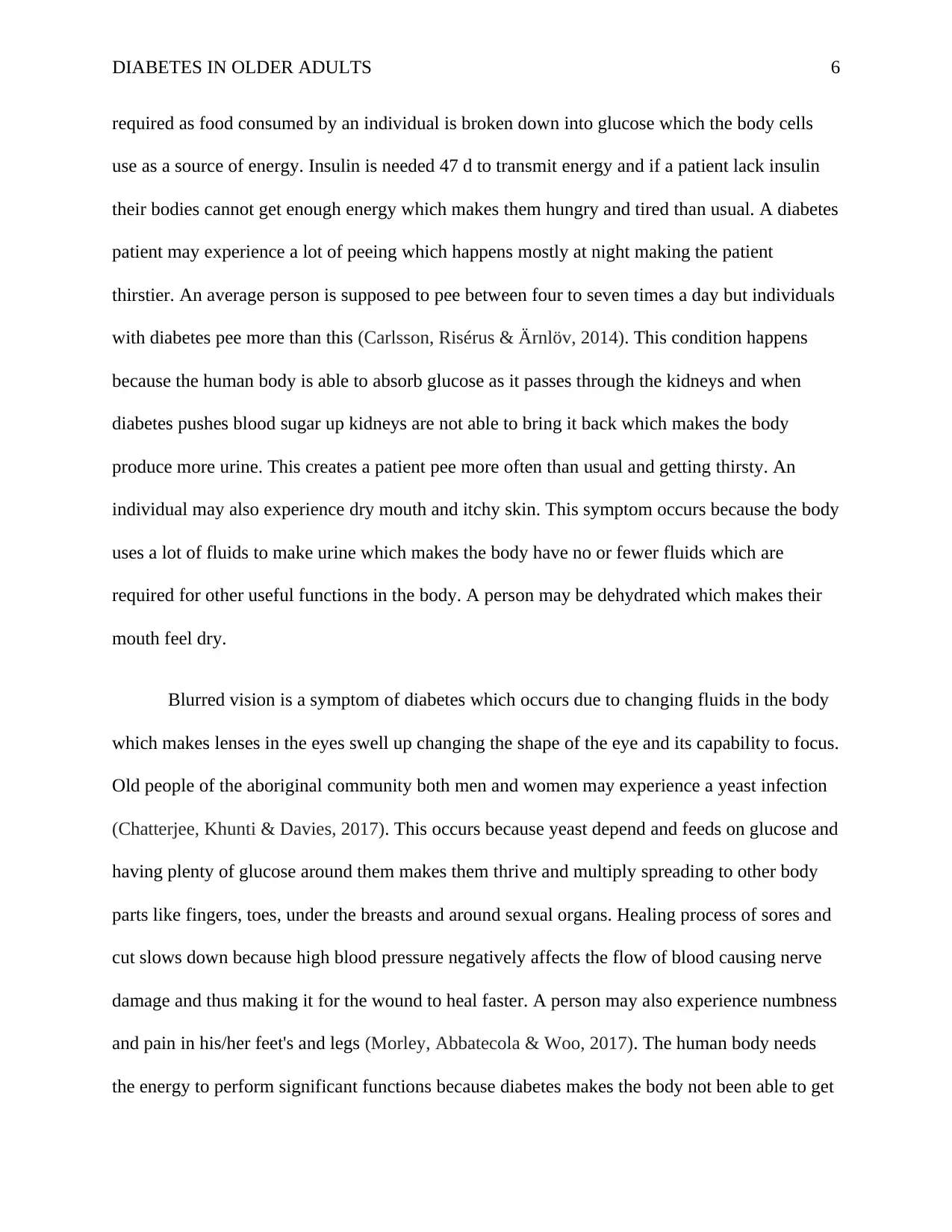
DIABETES IN OLDER ADULTS 6
required as food consumed by an individual is broken down into glucose which the body cells
use as a source of energy. Insulin is needed 47 d to transmit energy and if a patient lack insulin
their bodies cannot get enough energy which makes them hungry and tired than usual. A diabetes
patient may experience a lot of peeing which happens mostly at night making the patient
thirstier. An average person is supposed to pee between four to seven times a day but individuals
with diabetes pee more than this (Carlsson, Risérus & Ärnlöv, 2014). This condition happens
because the human body is able to absorb glucose as it passes through the kidneys and when
diabetes pushes blood sugar up kidneys are not able to bring it back which makes the body
produce more urine. This creates a patient pee more often than usual and getting thirsty. An
individual may also experience dry mouth and itchy skin. This symptom occurs because the body
uses a lot of fluids to make urine which makes the body have no or fewer fluids which are
required for other useful functions in the body. A person may be dehydrated which makes their
mouth feel dry.
Blurred vision is a symptom of diabetes which occurs due to changing fluids in the body
which makes lenses in the eyes swell up changing the shape of the eye and its capability to focus.
Old people of the aboriginal community both men and women may experience a yeast infection
(Chatterjee, Khunti & Davies, 2017). This occurs because yeast depend and feeds on glucose and
having plenty of glucose around them makes them thrive and multiply spreading to other body
parts like fingers, toes, under the breasts and around sexual organs. Healing process of sores and
cut slows down because high blood pressure negatively affects the flow of blood causing nerve
damage and thus making it for the wound to heal faster. A person may also experience numbness
and pain in his/her feet's and legs (Morley, Abbatecola & Woo, 2017). The human body needs
the energy to perform significant functions because diabetes makes the body not been able to get
required as food consumed by an individual is broken down into glucose which the body cells
use as a source of energy. Insulin is needed 47 d to transmit energy and if a patient lack insulin
their bodies cannot get enough energy which makes them hungry and tired than usual. A diabetes
patient may experience a lot of peeing which happens mostly at night making the patient
thirstier. An average person is supposed to pee between four to seven times a day but individuals
with diabetes pee more than this (Carlsson, Risérus & Ärnlöv, 2014). This condition happens
because the human body is able to absorb glucose as it passes through the kidneys and when
diabetes pushes blood sugar up kidneys are not able to bring it back which makes the body
produce more urine. This creates a patient pee more often than usual and getting thirsty. An
individual may also experience dry mouth and itchy skin. This symptom occurs because the body
uses a lot of fluids to make urine which makes the body have no or fewer fluids which are
required for other useful functions in the body. A person may be dehydrated which makes their
mouth feel dry.
Blurred vision is a symptom of diabetes which occurs due to changing fluids in the body
which makes lenses in the eyes swell up changing the shape of the eye and its capability to focus.
Old people of the aboriginal community both men and women may experience a yeast infection
(Chatterjee, Khunti & Davies, 2017). This occurs because yeast depend and feeds on glucose and
having plenty of glucose around them makes them thrive and multiply spreading to other body
parts like fingers, toes, under the breasts and around sexual organs. Healing process of sores and
cut slows down because high blood pressure negatively affects the flow of blood causing nerve
damage and thus making it for the wound to heal faster. A person may also experience numbness
and pain in his/her feet's and legs (Morley, Abbatecola & Woo, 2017). The human body needs
the energy to perform significant functions because diabetes makes the body not been able to get
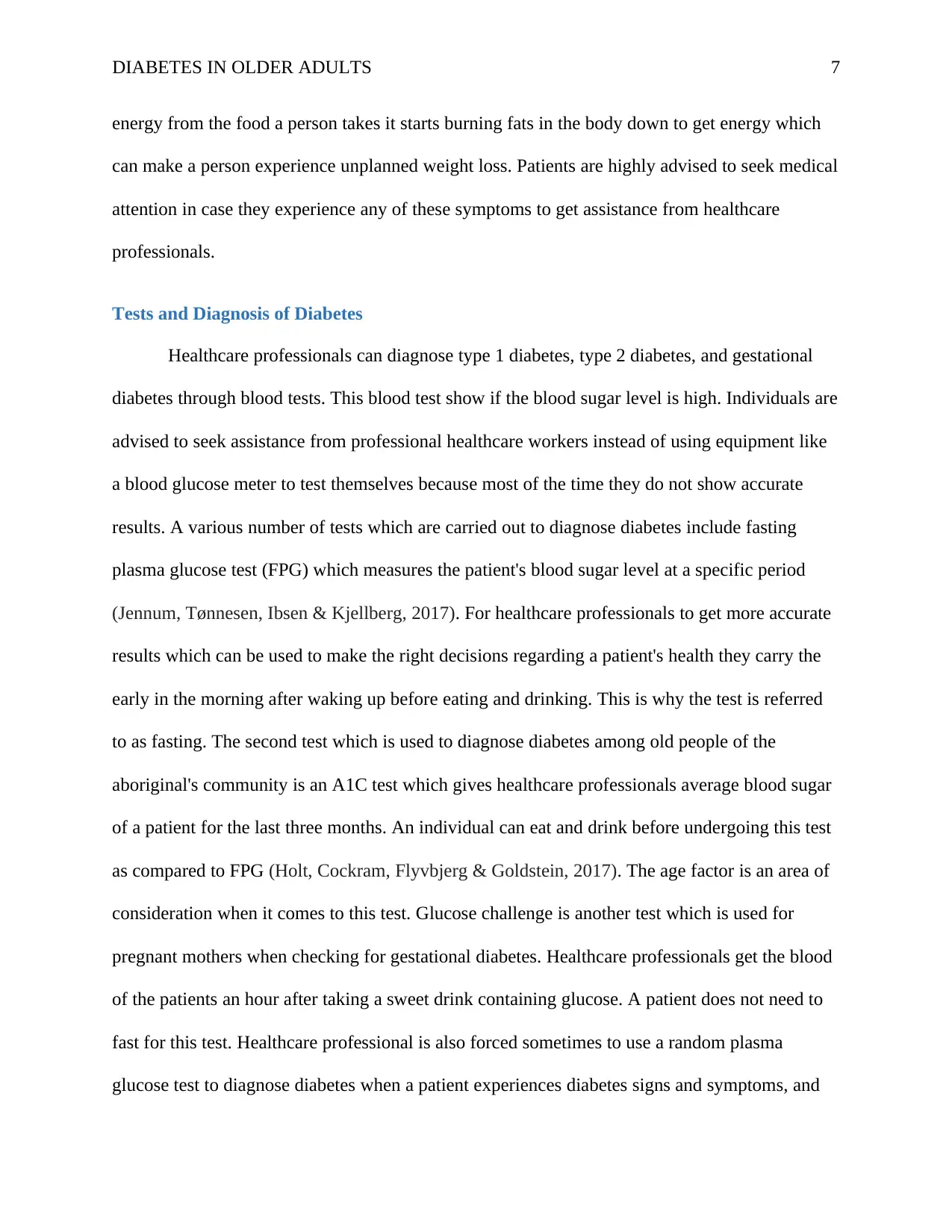
DIABETES IN OLDER ADULTS 7
energy from the food a person takes it starts burning fats in the body down to get energy which
can make a person experience unplanned weight loss. Patients are highly advised to seek medical
attention in case they experience any of these symptoms to get assistance from healthcare
professionals.
Tests and Diagnosis of Diabetes
Healthcare professionals can diagnose type 1 diabetes, type 2 diabetes, and gestational
diabetes through blood tests. This blood test show if the blood sugar level is high. Individuals are
advised to seek assistance from professional healthcare workers instead of using equipment like
a blood glucose meter to test themselves because most of the time they do not show accurate
results. A various number of tests which are carried out to diagnose diabetes include fasting
plasma glucose test (FPG) which measures the patient's blood sugar level at a specific period
(Jennum, Tønnesen, Ibsen & Kjellberg, 2017). For healthcare professionals to get more accurate
results which can be used to make the right decisions regarding a patient's health they carry the
early in the morning after waking up before eating and drinking. This is why the test is referred
to as fasting. The second test which is used to diagnose diabetes among old people of the
aboriginal's community is an A1C test which gives healthcare professionals average blood sugar
of a patient for the last three months. An individual can eat and drink before undergoing this test
as compared to FPG (Holt, Cockram, Flyvbjerg & Goldstein, 2017). The age factor is an area of
consideration when it comes to this test. Glucose challenge is another test which is used for
pregnant mothers when checking for gestational diabetes. Healthcare professionals get the blood
of the patients an hour after taking a sweet drink containing glucose. A patient does not need to
fast for this test. Healthcare professional is also forced sometimes to use a random plasma
glucose test to diagnose diabetes when a patient experiences diabetes signs and symptoms, and
energy from the food a person takes it starts burning fats in the body down to get energy which
can make a person experience unplanned weight loss. Patients are highly advised to seek medical
attention in case they experience any of these symptoms to get assistance from healthcare
professionals.
Tests and Diagnosis of Diabetes
Healthcare professionals can diagnose type 1 diabetes, type 2 diabetes, and gestational
diabetes through blood tests. This blood test show if the blood sugar level is high. Individuals are
advised to seek assistance from professional healthcare workers instead of using equipment like
a blood glucose meter to test themselves because most of the time they do not show accurate
results. A various number of tests which are carried out to diagnose diabetes include fasting
plasma glucose test (FPG) which measures the patient's blood sugar level at a specific period
(Jennum, Tønnesen, Ibsen & Kjellberg, 2017). For healthcare professionals to get more accurate
results which can be used to make the right decisions regarding a patient's health they carry the
early in the morning after waking up before eating and drinking. This is why the test is referred
to as fasting. The second test which is used to diagnose diabetes among old people of the
aboriginal's community is an A1C test which gives healthcare professionals average blood sugar
of a patient for the last three months. An individual can eat and drink before undergoing this test
as compared to FPG (Holt, Cockram, Flyvbjerg & Goldstein, 2017). The age factor is an area of
consideration when it comes to this test. Glucose challenge is another test which is used for
pregnant mothers when checking for gestational diabetes. Healthcare professionals get the blood
of the patients an hour after taking a sweet drink containing glucose. A patient does not need to
fast for this test. Healthcare professional is also forced sometimes to use a random plasma
glucose test to diagnose diabetes when a patient experiences diabetes signs and symptoms, and
Paraphrase This Document
Need a fresh take? Get an instant paraphrase of this document with our AI Paraphraser
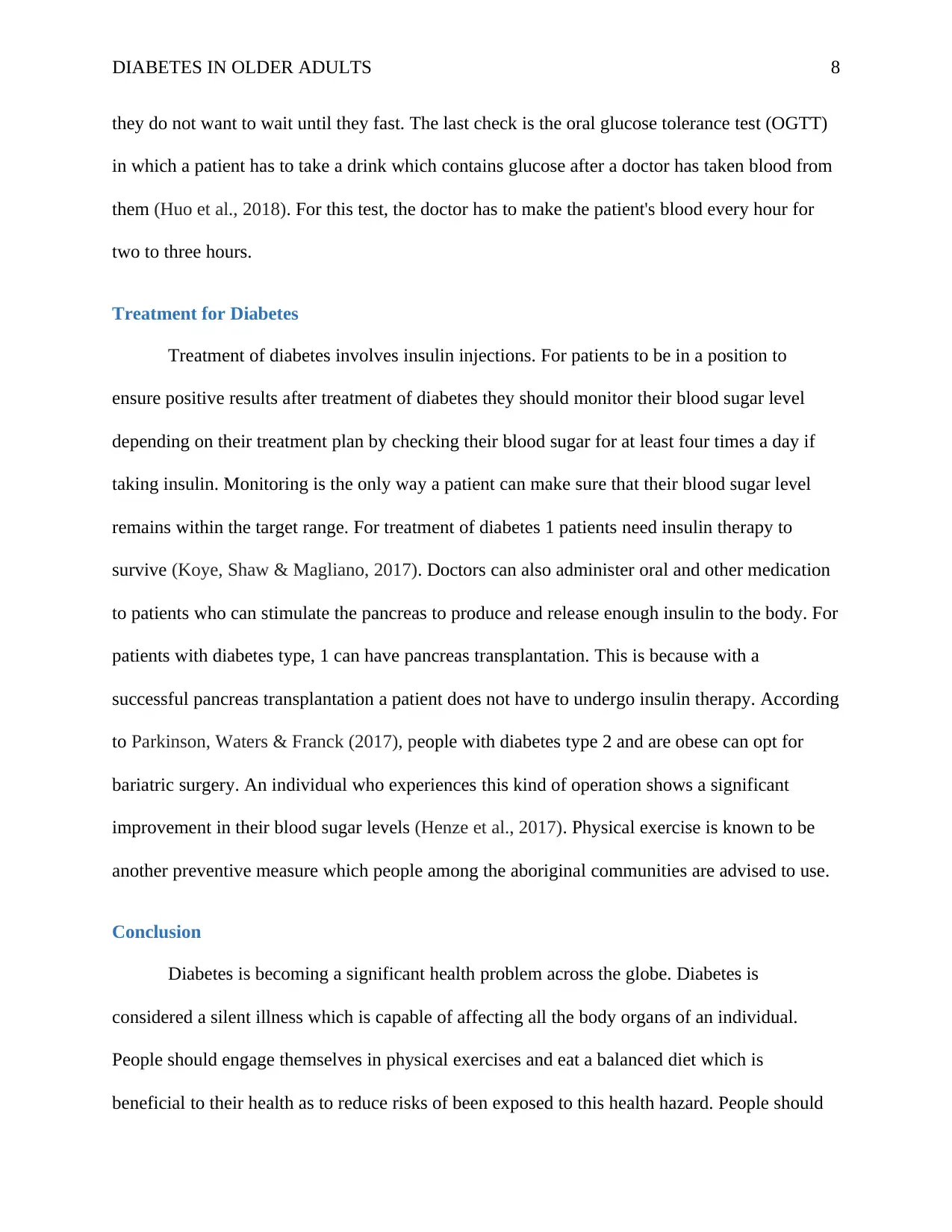
DIABETES IN OLDER ADULTS 8
they do not want to wait until they fast. The last check is the oral glucose tolerance test (OGTT)
in which a patient has to take a drink which contains glucose after a doctor has taken blood from
them (Huo et al., 2018). For this test, the doctor has to make the patient's blood every hour for
two to three hours.
Treatment for Diabetes
Treatment of diabetes involves insulin injections. For patients to be in a position to
ensure positive results after treatment of diabetes they should monitor their blood sugar level
depending on their treatment plan by checking their blood sugar for at least four times a day if
taking insulin. Monitoring is the only way a patient can make sure that their blood sugar level
remains within the target range. For treatment of diabetes 1 patients need insulin therapy to
survive (Koye, Shaw & Magliano, 2017). Doctors can also administer oral and other medication
to patients who can stimulate the pancreas to produce and release enough insulin to the body. For
patients with diabetes type, 1 can have pancreas transplantation. This is because with a
successful pancreas transplantation a patient does not have to undergo insulin therapy. According
to Parkinson, Waters & Franck (2017), people with diabetes type 2 and are obese can opt for
bariatric surgery. An individual who experiences this kind of operation shows a significant
improvement in their blood sugar levels (Henze et al., 2017). Physical exercise is known to be
another preventive measure which people among the aboriginal communities are advised to use.
Conclusion
Diabetes is becoming a significant health problem across the globe. Diabetes is
considered a silent illness which is capable of affecting all the body organs of an individual.
People should engage themselves in physical exercises and eat a balanced diet which is
beneficial to their health as to reduce risks of been exposed to this health hazard. People should
they do not want to wait until they fast. The last check is the oral glucose tolerance test (OGTT)
in which a patient has to take a drink which contains glucose after a doctor has taken blood from
them (Huo et al., 2018). For this test, the doctor has to make the patient's blood every hour for
two to three hours.
Treatment for Diabetes
Treatment of diabetes involves insulin injections. For patients to be in a position to
ensure positive results after treatment of diabetes they should monitor their blood sugar level
depending on their treatment plan by checking their blood sugar for at least four times a day if
taking insulin. Monitoring is the only way a patient can make sure that their blood sugar level
remains within the target range. For treatment of diabetes 1 patients need insulin therapy to
survive (Koye, Shaw & Magliano, 2017). Doctors can also administer oral and other medication
to patients who can stimulate the pancreas to produce and release enough insulin to the body. For
patients with diabetes type, 1 can have pancreas transplantation. This is because with a
successful pancreas transplantation a patient does not have to undergo insulin therapy. According
to Parkinson, Waters & Franck (2017), people with diabetes type 2 and are obese can opt for
bariatric surgery. An individual who experiences this kind of operation shows a significant
improvement in their blood sugar levels (Henze et al., 2017). Physical exercise is known to be
another preventive measure which people among the aboriginal communities are advised to use.
Conclusion
Diabetes is becoming a significant health problem across the globe. Diabetes is
considered a silent illness which is capable of affecting all the body organs of an individual.
People should engage themselves in physical exercises and eat a balanced diet which is
beneficial to their health as to reduce risks of been exposed to this health hazard. People should

DIABETES IN OLDER ADULTS 9
make sure that they visit healthcare professionals from time to time for screening and testing of
this infection. Friends, family members, and the community should not isolate people who are
suffering from diabetes as it is a manageable infection which they can manage and lead a healthy
life.
make sure that they visit healthcare professionals from time to time for screening and testing of
this infection. Friends, family members, and the community should not isolate people who are
suffering from diabetes as it is a manageable infection which they can manage and lead a healthy
life.
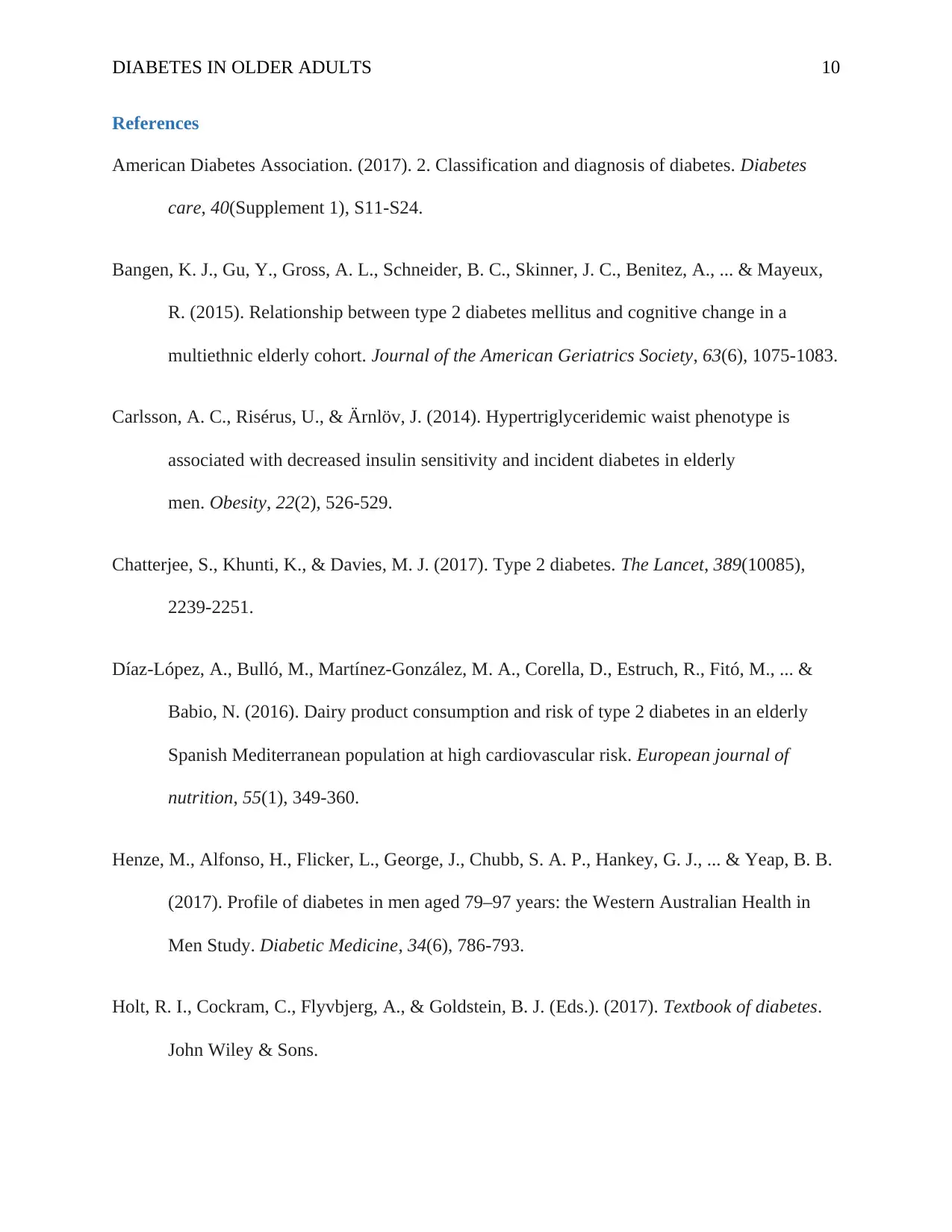
DIABETES IN OLDER ADULTS 10
References
American Diabetes Association. (2017). 2. Classification and diagnosis of diabetes. Diabetes
care, 40(Supplement 1), S11-S24.
Bangen, K. J., Gu, Y., Gross, A. L., Schneider, B. C., Skinner, J. C., Benitez, A., ... & Mayeux,
R. (2015). Relationship between type 2 diabetes mellitus and cognitive change in a
multiethnic elderly cohort. Journal of the American Geriatrics Society, 63(6), 1075-1083.
Carlsson, A. C., Risérus, U., & Ärnlöv, J. (2014). Hypertriglyceridemic waist phenotype is
associated with decreased insulin sensitivity and incident diabetes in elderly
men. Obesity, 22(2), 526-529.
Chatterjee, S., Khunti, K., & Davies, M. J. (2017). Type 2 diabetes. The Lancet, 389(10085),
2239-2251.
Díaz-López, A., Bulló, M., Martínez-González, M. A., Corella, D., Estruch, R., Fitó, M., ... &
Babio, N. (2016). Dairy product consumption and risk of type 2 diabetes in an elderly
Spanish Mediterranean population at high cardiovascular risk. European journal of
nutrition, 55(1), 349-360.
Henze, M., Alfonso, H., Flicker, L., George, J., Chubb, S. A. P., Hankey, G. J., ... & Yeap, B. B.
(2017). Profile of diabetes in men aged 79–97 years: the Western Australian Health in
Men Study. Diabetic Medicine, 34(6), 786-793.
Holt, R. I., Cockram, C., Flyvbjerg, A., & Goldstein, B. J. (Eds.). (2017). Textbook of diabetes.
John Wiley & Sons.
References
American Diabetes Association. (2017). 2. Classification and diagnosis of diabetes. Diabetes
care, 40(Supplement 1), S11-S24.
Bangen, K. J., Gu, Y., Gross, A. L., Schneider, B. C., Skinner, J. C., Benitez, A., ... & Mayeux,
R. (2015). Relationship between type 2 diabetes mellitus and cognitive change in a
multiethnic elderly cohort. Journal of the American Geriatrics Society, 63(6), 1075-1083.
Carlsson, A. C., Risérus, U., & Ärnlöv, J. (2014). Hypertriglyceridemic waist phenotype is
associated with decreased insulin sensitivity and incident diabetes in elderly
men. Obesity, 22(2), 526-529.
Chatterjee, S., Khunti, K., & Davies, M. J. (2017). Type 2 diabetes. The Lancet, 389(10085),
2239-2251.
Díaz-López, A., Bulló, M., Martínez-González, M. A., Corella, D., Estruch, R., Fitó, M., ... &
Babio, N. (2016). Dairy product consumption and risk of type 2 diabetes in an elderly
Spanish Mediterranean population at high cardiovascular risk. European journal of
nutrition, 55(1), 349-360.
Henze, M., Alfonso, H., Flicker, L., George, J., Chubb, S. A. P., Hankey, G. J., ... & Yeap, B. B.
(2017). Profile of diabetes in men aged 79–97 years: the Western Australian Health in
Men Study. Diabetic Medicine, 34(6), 786-793.
Holt, R. I., Cockram, C., Flyvbjerg, A., & Goldstein, B. J. (Eds.). (2017). Textbook of diabetes.
John Wiley & Sons.
Secure Best Marks with AI Grader
Need help grading? Try our AI Grader for instant feedback on your assignments.
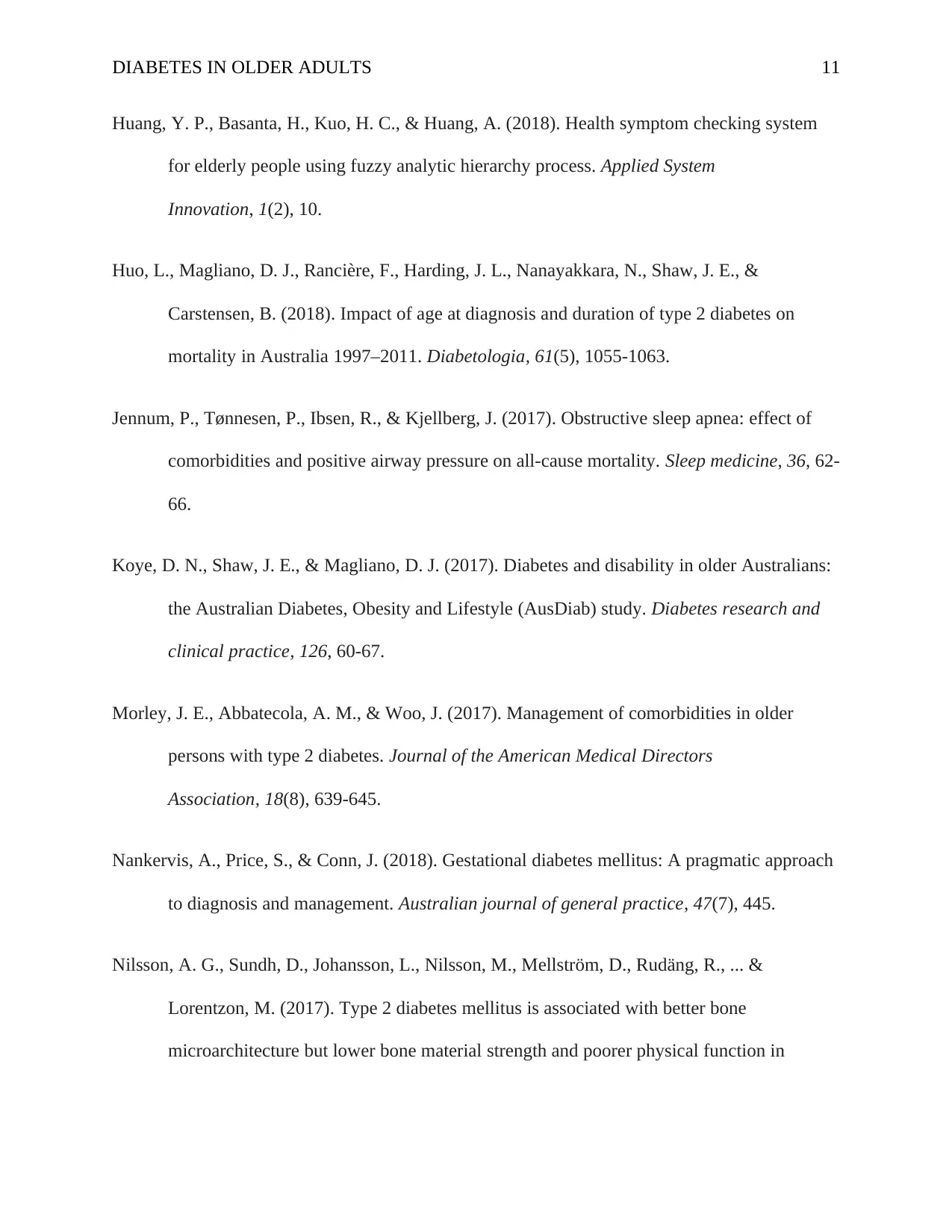
DIABETES IN OLDER ADULTS 11
Huang, Y. P., Basanta, H., Kuo, H. C., & Huang, A. (2018). Health symptom checking system
for elderly people using fuzzy analytic hierarchy process. Applied System
Innovation, 1(2), 10.
Huo, L., Magliano, D. J., Rancière, F., Harding, J. L., Nanayakkara, N., Shaw, J. E., &
Carstensen, B. (2018). Impact of age at diagnosis and duration of type 2 diabetes on
mortality in Australia 1997–2011. Diabetologia, 61(5), 1055-1063.
Jennum, P., Tønnesen, P., Ibsen, R., & Kjellberg, J. (2017). Obstructive sleep apnea: effect of
comorbidities and positive airway pressure on all-cause mortality. Sleep medicine, 36, 62-
66.
Koye, D. N., Shaw, J. E., & Magliano, D. J. (2017). Diabetes and disability in older Australians:
the Australian Diabetes, Obesity and Lifestyle (AusDiab) study. Diabetes research and
clinical practice, 126, 60-67.
Morley, J. E., Abbatecola, A. M., & Woo, J. (2017). Management of comorbidities in older
persons with type 2 diabetes. Journal of the American Medical Directors
Association, 18(8), 639-645.
Nankervis, A., Price, S., & Conn, J. (2018). Gestational diabetes mellitus: A pragmatic approach
to diagnosis and management. Australian journal of general practice, 47(7), 445.
Nilsson, A. G., Sundh, D., Johansson, L., Nilsson, M., Mellström, D., Rudäng, R., ... &
Lorentzon, M. (2017). Type 2 diabetes mellitus is associated with better bone
microarchitecture but lower bone material strength and poorer physical function in
Huang, Y. P., Basanta, H., Kuo, H. C., & Huang, A. (2018). Health symptom checking system
for elderly people using fuzzy analytic hierarchy process. Applied System
Innovation, 1(2), 10.
Huo, L., Magliano, D. J., Rancière, F., Harding, J. L., Nanayakkara, N., Shaw, J. E., &
Carstensen, B. (2018). Impact of age at diagnosis and duration of type 2 diabetes on
mortality in Australia 1997–2011. Diabetologia, 61(5), 1055-1063.
Jennum, P., Tønnesen, P., Ibsen, R., & Kjellberg, J. (2017). Obstructive sleep apnea: effect of
comorbidities and positive airway pressure on all-cause mortality. Sleep medicine, 36, 62-
66.
Koye, D. N., Shaw, J. E., & Magliano, D. J. (2017). Diabetes and disability in older Australians:
the Australian Diabetes, Obesity and Lifestyle (AusDiab) study. Diabetes research and
clinical practice, 126, 60-67.
Morley, J. E., Abbatecola, A. M., & Woo, J. (2017). Management of comorbidities in older
persons with type 2 diabetes. Journal of the American Medical Directors
Association, 18(8), 639-645.
Nankervis, A., Price, S., & Conn, J. (2018). Gestational diabetes mellitus: A pragmatic approach
to diagnosis and management. Australian journal of general practice, 47(7), 445.
Nilsson, A. G., Sundh, D., Johansson, L., Nilsson, M., Mellström, D., Rudäng, R., ... &
Lorentzon, M. (2017). Type 2 diabetes mellitus is associated with better bone
microarchitecture but lower bone material strength and poorer physical function in
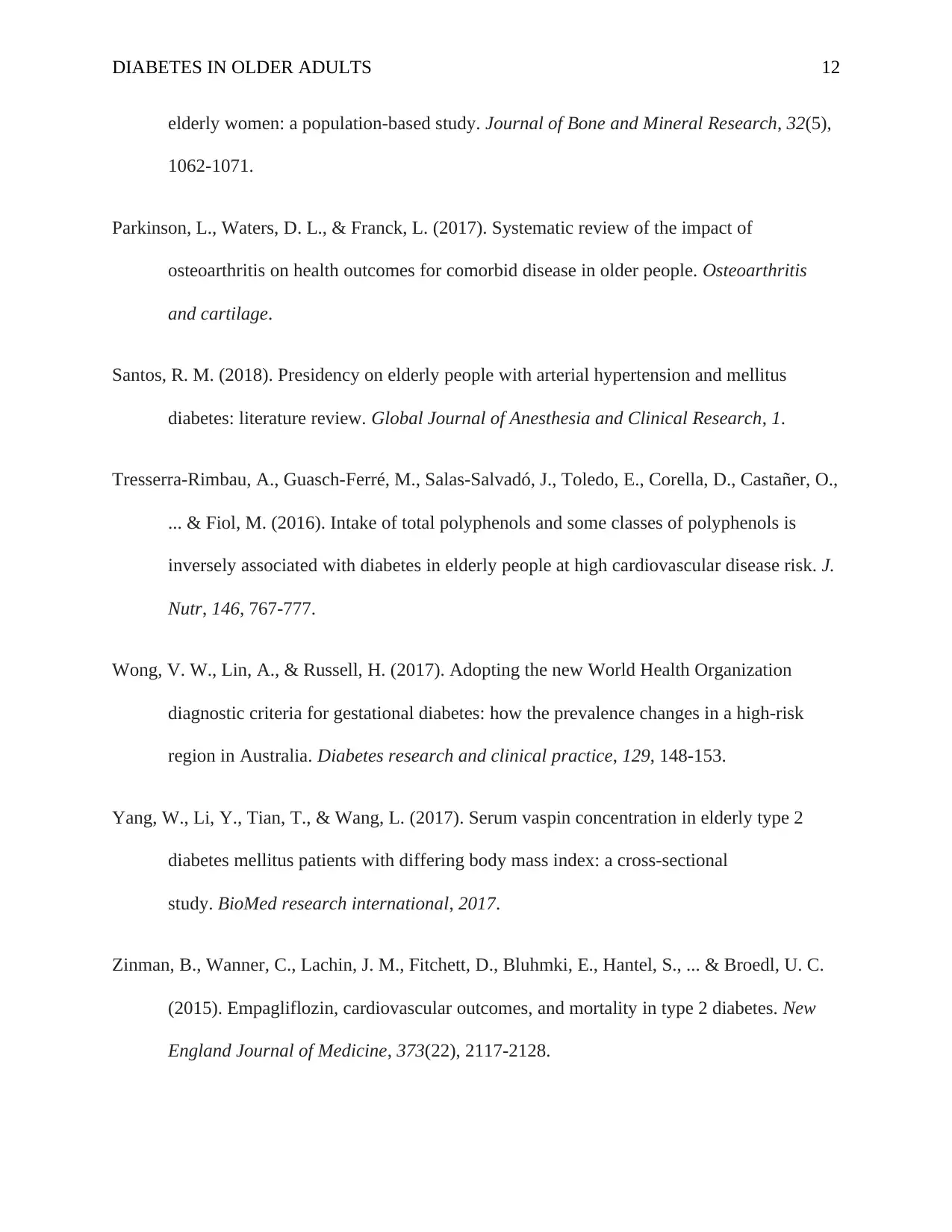
DIABETES IN OLDER ADULTS 12
elderly women: a population‐based study. Journal of Bone and Mineral Research, 32(5),
1062-1071.
Parkinson, L., Waters, D. L., & Franck, L. (2017). Systematic review of the impact of
osteoarthritis on health outcomes for comorbid disease in older people. Osteoarthritis
and cartilage.
Santos, R. M. (2018). Presidency on elderly people with arterial hypertension and mellitus
diabetes: literature review. Global Journal of Anesthesia and Clinical Research, 1.
Tresserra-Rimbau, A., Guasch-Ferré, M., Salas-Salvadó, J., Toledo, E., Corella, D., Castañer, O.,
... & Fiol, M. (2016). Intake of total polyphenols and some classes of polyphenols is
inversely associated with diabetes in elderly people at high cardiovascular disease risk. J.
Nutr, 146, 767-777.
Wong, V. W., Lin, A., & Russell, H. (2017). Adopting the new World Health Organization
diagnostic criteria for gestational diabetes: how the prevalence changes in a high-risk
region in Australia. Diabetes research and clinical practice, 129, 148-153.
Yang, W., Li, Y., Tian, T., & Wang, L. (2017). Serum vaspin concentration in elderly type 2
diabetes mellitus patients with differing body mass index: a cross-sectional
study. BioMed research international, 2017.
Zinman, B., Wanner, C., Lachin, J. M., Fitchett, D., Bluhmki, E., Hantel, S., ... & Broedl, U. C.
(2015). Empagliflozin, cardiovascular outcomes, and mortality in type 2 diabetes. New
England Journal of Medicine, 373(22), 2117-2128.
elderly women: a population‐based study. Journal of Bone and Mineral Research, 32(5),
1062-1071.
Parkinson, L., Waters, D. L., & Franck, L. (2017). Systematic review of the impact of
osteoarthritis on health outcomes for comorbid disease in older people. Osteoarthritis
and cartilage.
Santos, R. M. (2018). Presidency on elderly people with arterial hypertension and mellitus
diabetes: literature review. Global Journal of Anesthesia and Clinical Research, 1.
Tresserra-Rimbau, A., Guasch-Ferré, M., Salas-Salvadó, J., Toledo, E., Corella, D., Castañer, O.,
... & Fiol, M. (2016). Intake of total polyphenols and some classes of polyphenols is
inversely associated with diabetes in elderly people at high cardiovascular disease risk. J.
Nutr, 146, 767-777.
Wong, V. W., Lin, A., & Russell, H. (2017). Adopting the new World Health Organization
diagnostic criteria for gestational diabetes: how the prevalence changes in a high-risk
region in Australia. Diabetes research and clinical practice, 129, 148-153.
Yang, W., Li, Y., Tian, T., & Wang, L. (2017). Serum vaspin concentration in elderly type 2
diabetes mellitus patients with differing body mass index: a cross-sectional
study. BioMed research international, 2017.
Zinman, B., Wanner, C., Lachin, J. M., Fitchett, D., Bluhmki, E., Hantel, S., ... & Broedl, U. C.
(2015). Empagliflozin, cardiovascular outcomes, and mortality in type 2 diabetes. New
England Journal of Medicine, 373(22), 2117-2128.
1 out of 12
Related Documents
Your All-in-One AI-Powered Toolkit for Academic Success.
+13062052269
info@desklib.com
Available 24*7 on WhatsApp / Email
![[object Object]](/_next/static/media/star-bottom.7253800d.svg)
Unlock your academic potential
© 2024 | Zucol Services PVT LTD | All rights reserved.





